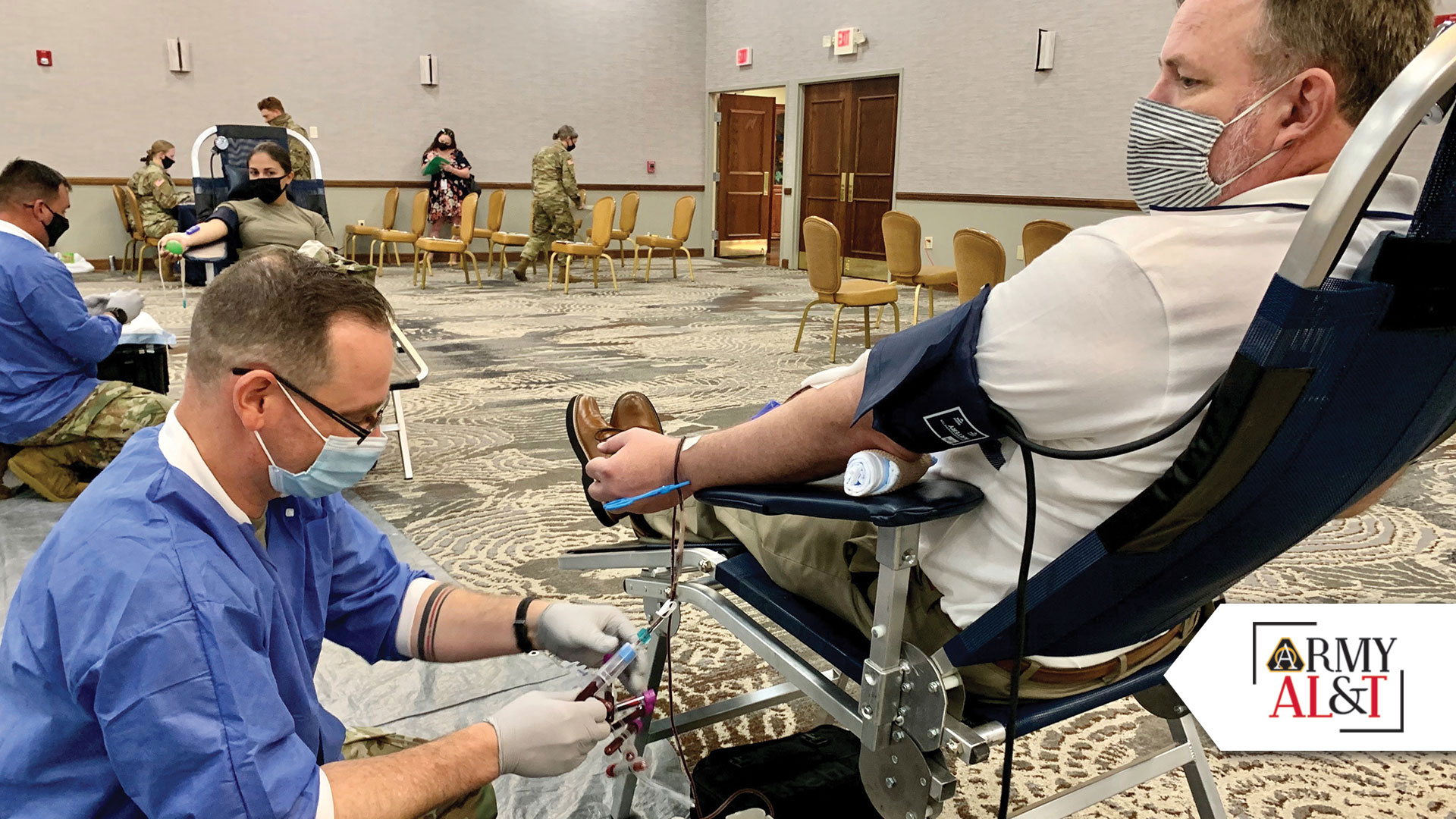
QUICK DRAW: Sgt. Brett Knox with the Kendrick Memorial Blood Center, located outside Fort Gordon, Georgia, takes blood from Patrick Young, an employee at Winn Army Community Hospital, as a participant in the DOD COVID-19 Convalescent Plasma Program in September. (Photo by Zach Rehnstrom, Winn Army Community Hospital)
FROM THE ARMY ACQUISITION EXECUTIVE
DR. BRUCE D. JETTE
The Army, ASA(ALT) and the U.S. defense industry work together to overcome COVID-19 difficulties.
This issue gives me another opportunity to praise the transparent and productive working relationship we’ve established with our commercial and organic industrial base partners, particularly throughout the COVID-19 pandemic. Earlier this year, the Army and our defense industry colleagues were presented with unique challenges, and we’ve faced (and continue to face) them together.
The Army has issued more than 25 policies implementing expanded authorities and acquisition flexibilities for our industry partners, allowing a rapid response from the Army contracting enterprise. These include increasing progress payment rates up to 90 percent for large businesses or 95 percent for small businesses and granting limited exemptions and waivers from certain federal contracting requirements.
In many cases, we’ve also accelerated payment schedules and shortened payment times from 30 days to 15. We worked hard to make sure the cash flow was managed in the industrial base and our industry partners did the yeoman’s work in trying to manage that as well. Hundreds of millions of dollars, particularly with our large vendors, were advanced to subcontractors so they could stay afloat. This extraordinary teamwork is exemplary, and it’s keeping both our testing and fielding schedules, as well as our programs and modernization priorities, largely on track.
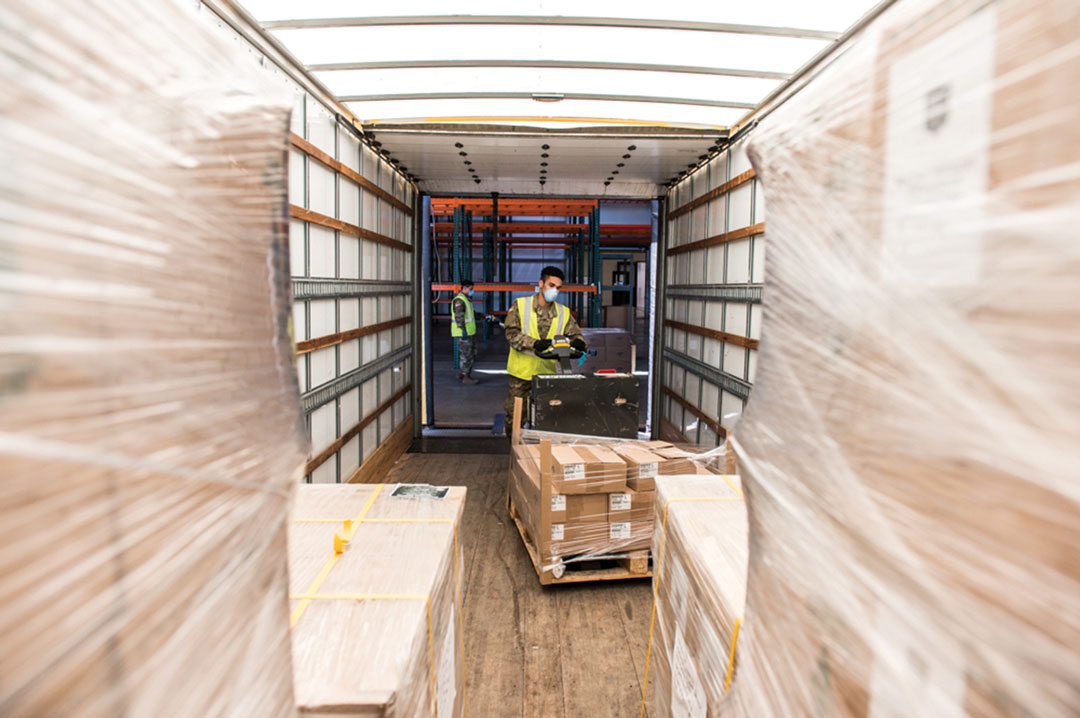
LOAD IT UP: Oregon Army National Guard Soldiers in April load shipments of personal protective equipment (PPE) that are being distributed throughout the counties and tribes of Oregon. These shipments of PPE were sent to Oregon by the U.S. Agency for International Development from Dubai. (Photo by Sgt. 1st Class Zachary Holden, Oregon Military Department)
For me personally, my daily report on the health of the industrial base that once spanned more than 80 pages is now a weekly report. Early on, I spent many hours each week in conference calls and on the phone with company executives. I continue this outreach today, but now have an opportunity to travel, although with limitations, and see firsthand the resilience of our industry partners. However, I continue to miss having engagements where I am able to visit multiple companies in one setting. Those 20 to 30 minutes together with company representatives in a face-to-face discussion at events—such as those held by the Association of the United States Army, the National Defense Industrial Association, the Aerospace Industries Association and other important organizations—will be hard to do again until the restrictions related to COVID-19 are resolved.
PEOPLE ARE THE MVPs
As we assess the industrial base and programmatic impacts of the pandemic, I am reminded once again that people are our most valuable asset. It’s significant how we’ve learned to take better care of our people. As I write this, the Pentagon is currently at 50 percent staffing. Some observers have said that only essential people now go to work at the Pentagon; I tell them, all workers are essential. The question is, how do we make it effective for our workforce to do their jobs while remaining safe and protected? We’ve found numerous ways to do that, both within the Army and in industry. The safety and health of our workforce—and the workforces of our industry partners—continues to be my top priority.
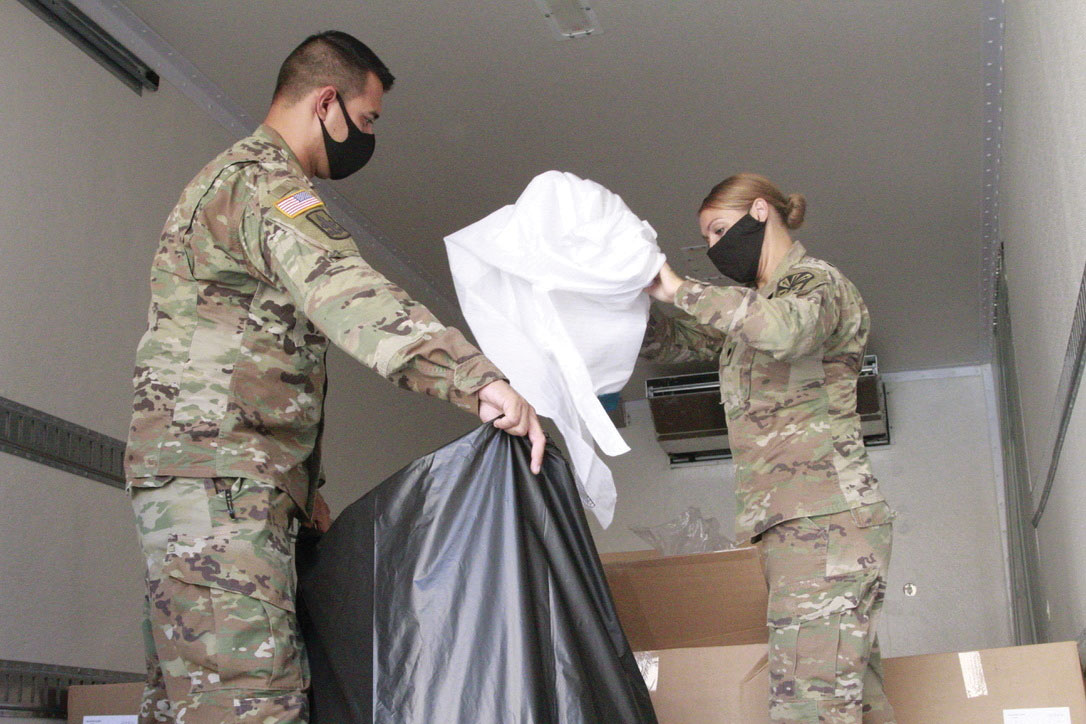
PASS IT ON: Arizona Army National Guard service members pick up and deliver boxes of PPE gowns to local nursing homes and rehab centers in September at the Fabric Fashion Resources Innovation Center in Tempe. (Photo by Spc. Thurman Snyder, 123rd Mobile Public Affairs Detachment)
Within the acquisition, logistics and technology community, we’ve adopted a three-pronged approach to protecting our workforce and our warfighters. This includes:
• Protect and prevent—A comprehensive effort employing personal protective equipment, cloth face coverings, disinfecting technology and vaccine development.
• Detect and screen—A layered approach comprising diagnostic instruments and tests, mobile laboratories, thermal-imaging screening devices for fever detection, biosurveillance technology and contact tracing.
• Treat and return to duty—Deployment of therapeutics and other COVID-19 treatments to effectively treat and return personnel to duty.
For most people, the U.S. Army doesn’t come readily to mind when they think about the national response to the COVID-19 pandemic. Still, the Army—and the acquisition community in particular—have a critically important role. Our COVID-19 Task Force monitors impacts to the commercial and organic defense industrial base, and addresses the impacts to manufacturing, engineering, service and supply chains as a result of company closures, minimal manning and other restrictions within the defense industrial base. In addition, the Task Force assesses programmatic impacts that result from industrial base constraints on Army testing and fielding of capabilities to our Soldiers.
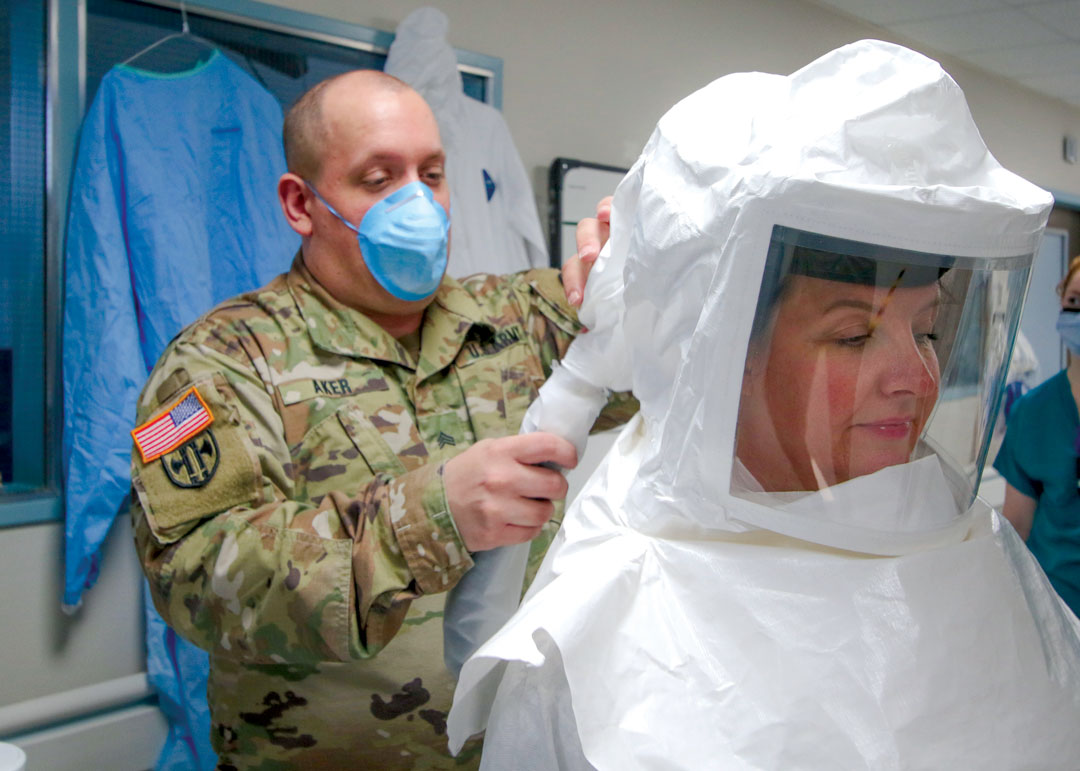
WELL SUITED: U.S. medical personnel at the Landstuhl Regional Medical Center in Germany conduct training in April on the Powered Air-Purifying Respirator system, a full-body respirator used to safeguard staff members from contaminants. (Photo by Marcy Sanchez, Landstuhl Regional Medical Center)
TASKED WITH EXCELLENCE
The Task Force also has an important role in coordinating the Joint Program Executive Office for Chemical, Biological, Radiological and Nuclear Defense (JPEO-CBRND) response. The JPEO-CBRND is the primary acquisition office supporting the COVID-19 response and the primary DOD office supporting Operation Warp Speed, a federal interagency organization with a goal of producing and delivering 300 million doses of safe and effective vaccines, with the initial doses available by January 2021.
The JPEO-CBRND has undertaken herculean efforts to support as needed, from helping develop capabilities in detection, diagnosis, treatment and vaccines for warfighters, to tools that increase situational awareness of the coronavirus.
When the pandemic hit, JPEO-CBRND re-prioritized and shifted to fielding the Army’s testing and protection requirements, such as diagnostics, mobile labs and personal protective equipment to highly impacted DOD locations. It then supported DOD’s acceleration program providing medical countermeasures, including vaccines and therapeutics, diagnostics and testing capabilities, personal protective equipment, decontamination capabilities and disinfectants, and enablers such as needles, syringes, serology kits, collection kits, thermometers, initial standoff screening capability like thermal cameras and fill-finish capabilities, among others.
JPEO-CBRND and the U.S. Army Medical Research and Development Command collaborate frequently, leveraging each organization’s unique skill sets as a force multiplier to deliver medical products and countermeasures to our nation’s armed services. The U.S. Army Medical Research and Development Command focuses primarily on research and development to address non-CBRN issues such as endemic diseases. The JPEO-CBRND focuses on CBRN threats, working with government science and technology organizations and industry partners through contracts and other agreements to transition, develop and field critical CBRN medical countermeasures to our warfighters in operations across the globe.
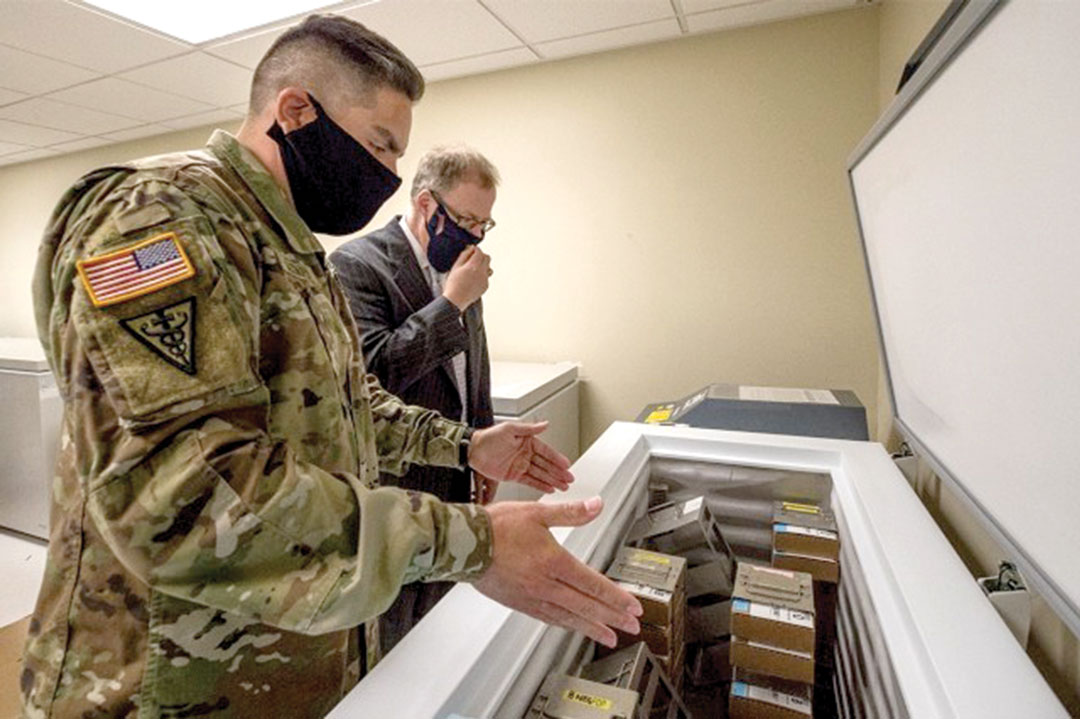
COLD STORAGE: Maj. Juan Guzman, the chief of the Armed Services Blood Bank Center – Pacific Northwest, shows Assistant Secretary of Defense for Health Affairs Thomas McCaffery where the center stores the convalescent plasma it collects from donors who have recovered from COVID-19, during McCaffery’s visit in July to the center at Madigan Army Medical Center on Joint Base Lewis-McChord in Tacoma, Washington. (Photo by John Wayne Liston, Medical Research and Development Command)
CONCLUSION
Working together to combat COVID-19 is imperative, and no one organization or department can possibly tackle the complexities of the mission alone. The federal interagency partnership with industry relies heavily on coordination and collaboration among scientists, program management offices, company representatives, regulatory experts, legal counsel, contracting specialists and leadership to streamline efforts and deliver results for the benefit of the nation, the Army and the Soldiers we serve.
Read the full article in the Fall 2020 issue of Army AL&T magazine.
Subscribe to Army AL&T News – the premier online news source for the Army Acquisition Workforce. ![]() Subscribe
Subscribe







